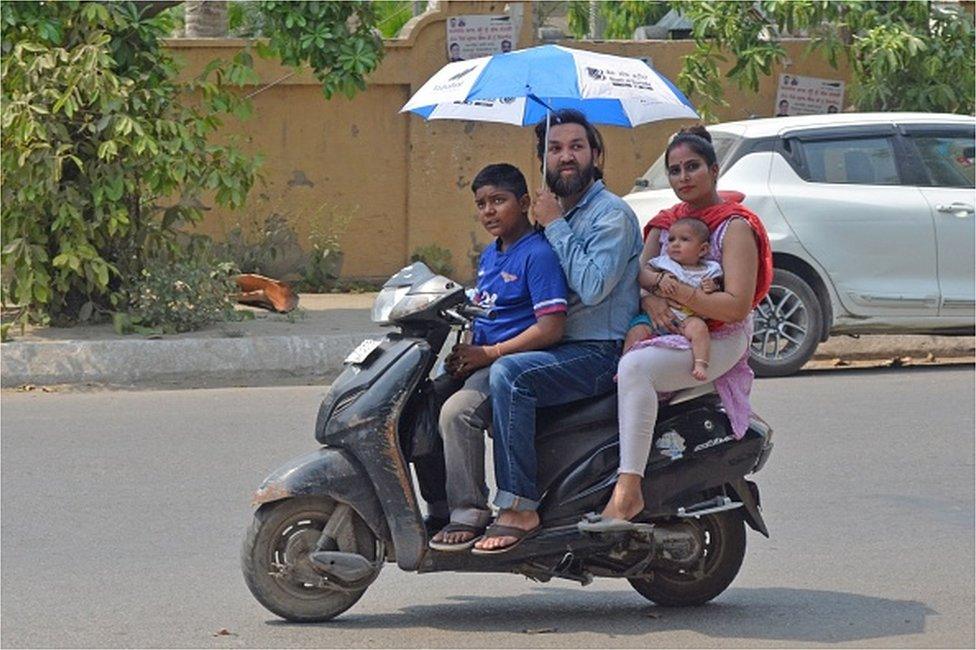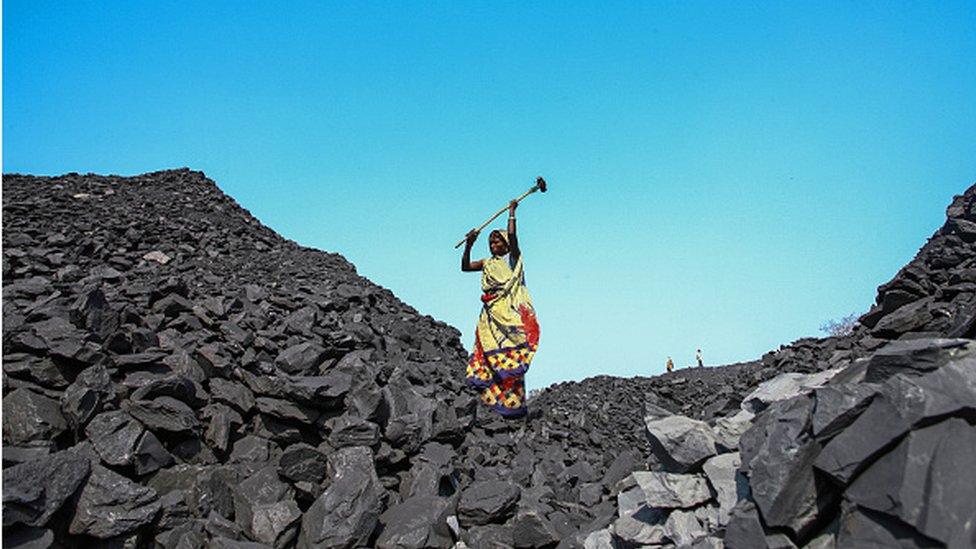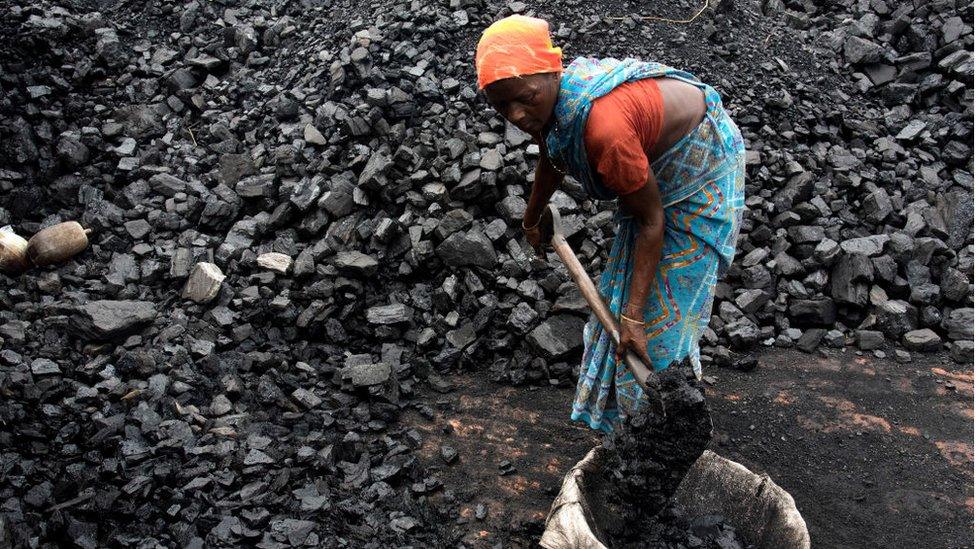Coal shortage and heatwave spark India's power woes
- Published

Three-quarters of the electricity produced in India uses coal
For more than a month, Sandeep Mall's engineering goods factory next to the Indian capital, Delhi, has been facing crippling power cuts, sometimes up to 14 hours a day.
The 50-odd machines in the factory located in a major manufacturing hub in Faridabad make products for aeronautics, automobile, mining and construction industries.
"Every time the power goes off, the machines stop, the semi-finished products get rejected and we have to start all over again," Mr Mall says.
That happens when he fires up diesel-powered generators to keep the factory running. He says it is three times as expensive to run it on diesel than what he pays to the local power transmission authority.
"This erodes my competitiveness, cuts into my profits. It's a complete mess, and is very frustrating," Mr Mall says.
"These are the worst power cuts I have faced in over a decade."
Beginning in April, power cuts and outages have rippled across India, slowing factories, closing schools, and sparking demonstrations. Two in three households said they were facing power outages, according to more than 21,000 people in 322 districts surveyed by LocalCircles, a polling agency. One in three households reported outages of two hours or more each day.

Sandeep Mall's engineering products factory near Delhi has been facing outages up to 14 hours a day
At least nine states, including Haryana, where Mr Mall's factory is located, are suffering from prolonged outages. The main reason why electricity is in such short supply is a shortage of coal.
India is the world's second-largest producer and consumer of coal. The fossil fuel keeps the country's lights on: three-quarters of the electricity produced uses coal. India sits atop the world's third-highest reserves of coal and boasts of the world's largest coal mining company but per person consumption is still modest.
India imports a little under a quarter of its consumption: much of it is coking coal which is used in blast furnaces for making steel and is not available domestically. Yet there are perpetual shortages.
Last October, India teetered on the brink of a power crisis when stocks at more than half of the country's 135 coal-fired plants ran critically low, or below 25% of normal levels. Now coal stocks are said to be critically low in 108 of its 173 power plants. The war in Ukraine means global prices of coal and natural gas have soared, making imports unaffordable.
"This crisis is worse than what it was last year as the demand is actually high. A perfect storm has built up now, and there are many reasons to blame," says Rahul Tongia, a senior fellow with the Centre for Social and Economic Progress (CSEP), a Delhi-based think tank.

Average temperatures in northern and central India have been the highest in more than 120 years
An earlier-than-expected searing heatwave - average temperatures in April in northern and central India were the highest in more than 120 years - has pushed demand for electricity to record levels. This came on top of an uptick in demand following the reopening of the economy after two years of pandemic lockdowns.
Also, India's railways were again carrying more passenger traffic on shared tracks with freight, leading to fewer wagons hauling coal across the country.
"It is not that India is running out of coal in an absolute sense. We are essentially facing a stockpile problem, and it is not new. We have a system designed around managing scarcity and linkages. It's not designed for efficiency, nor for proper risk allocation," says Mr Tongia.
Demand for electricity is seasonal, and building a stockpile costs more money and is time-consuming, experts say. India has traditionally reinforced supplies by importing coal. "One cannot easily fix under stock-piling over months with over-supply," says Mr Tongia.
The government says it is doing all it can do to ensure supplies. Coal India, the world's largest coal miner, has increased production by 12%, "strengthening India's energy security", according to the federal coal ministry. It also despatched 49.7 million metric tonnes of coal to the power generating companies in April, a 15% rise over the same month last year, external. The railways have cancelled more than a thousand passenger trains to transport more coal to fuel-starved plants.

India sits atop the world's third-highest reserves of coal
Coal generates ample revenues for the federal and state governments. But the "dysfunctional" relationship between coal and electricity in India doesn't help matters, notes energy expert Daljit Singh in Future Of Coal In India, a book on the subject. India's power plants procure coal "through multiple channels with a bewildering array of pricing regimes", he says.
The price that a plant pays for the same coal at the same location could vary, depending on whether the plant is owned privately or by the government, the date when it was commissioned and the existence of "power purchase agreements" with a large number of electricity distribution companies, many of which are groaning under debt.
"The approach is tilted in favour of power plants owned by the governments," he says.
The railways, which is India's largest employer, over-charges on ferrying coal - the largest commodity it hauls - to keep passenger fares down. This is just one example, says Mr Tongia, "of numerous distortions that create winners and losers in the coal ecosystem, making change much harder than what it would be based solely on the fundamentals".
India has promised to increase renewable-energy capacity to 450 gigawatts by 2030 to help wean itself off the dependence on coal. "But the rise of renewables hasn't been sufficient to end the growth of coal. India's priority should be to clean up its coal instead of wishing it away, says Mr Tongia. Yet, India's coal is high in ash - about 35% or more - which makes it very polluting. Coal emissions, according to Greenpeace, kill more than 100,000 Indians every year.
Back in Faridabad, Mr Mall says he has never seen a single day of uninterrupted power supply ever since his small factory began operations 27 years ago. But the ongoing blackouts has left him completely exhausted.
"This is no way to do business. After the jobs we generate and taxes we pay, this is what we get?"
Related topics
- Published11 October 2021

- Published28 September 2021

- Published21 October 2021

- Published30 March 2022

